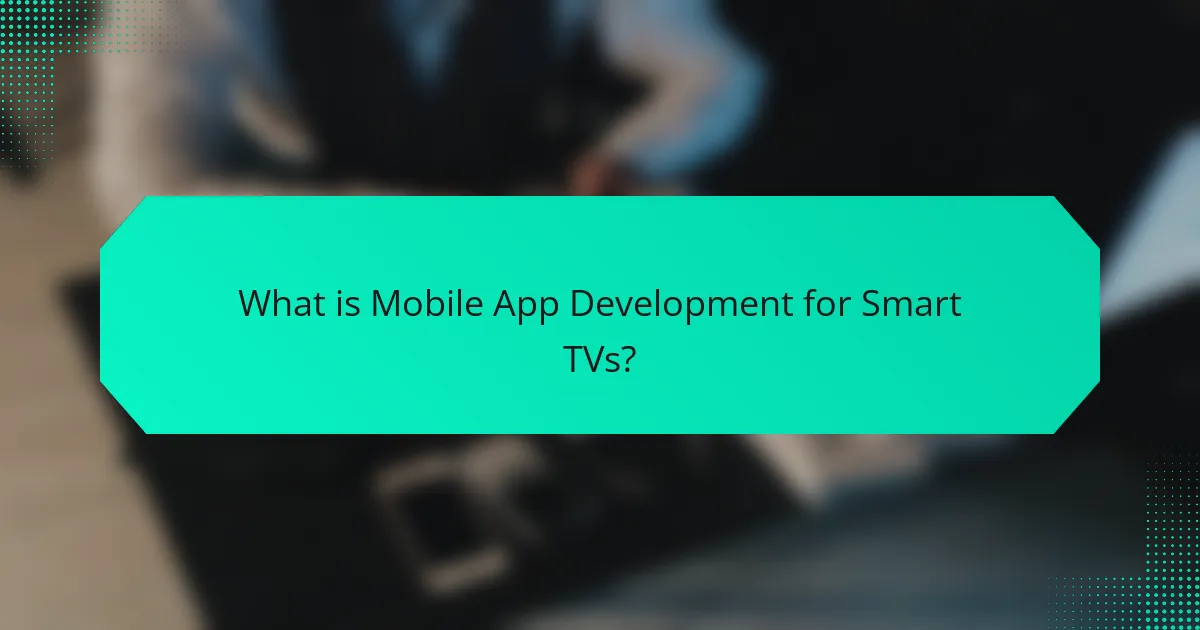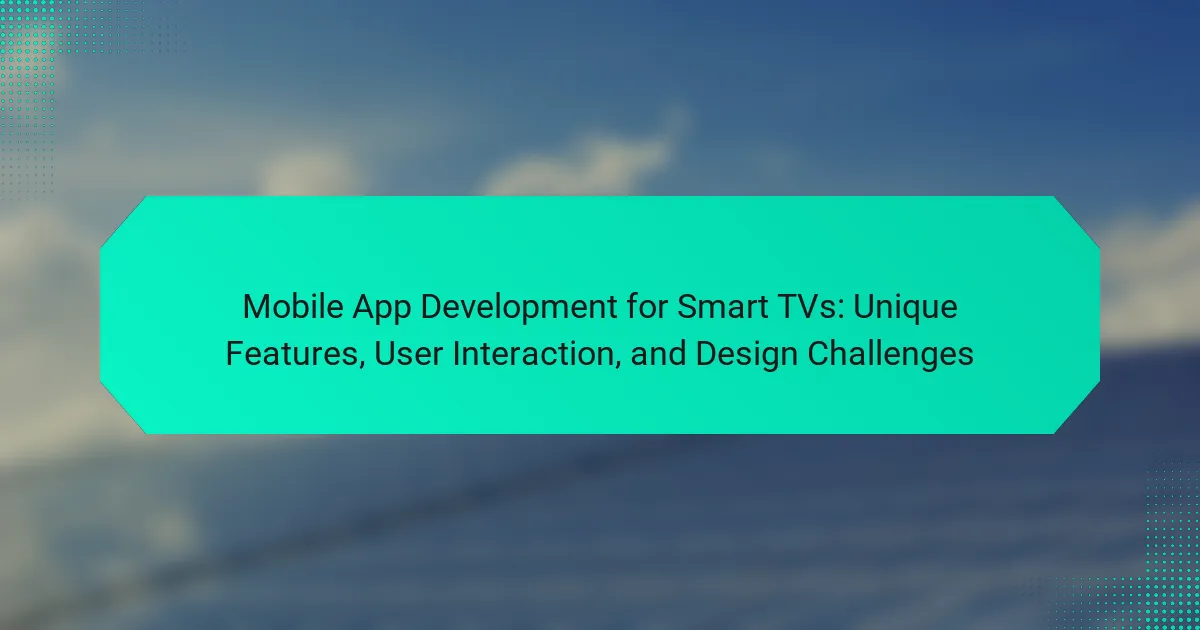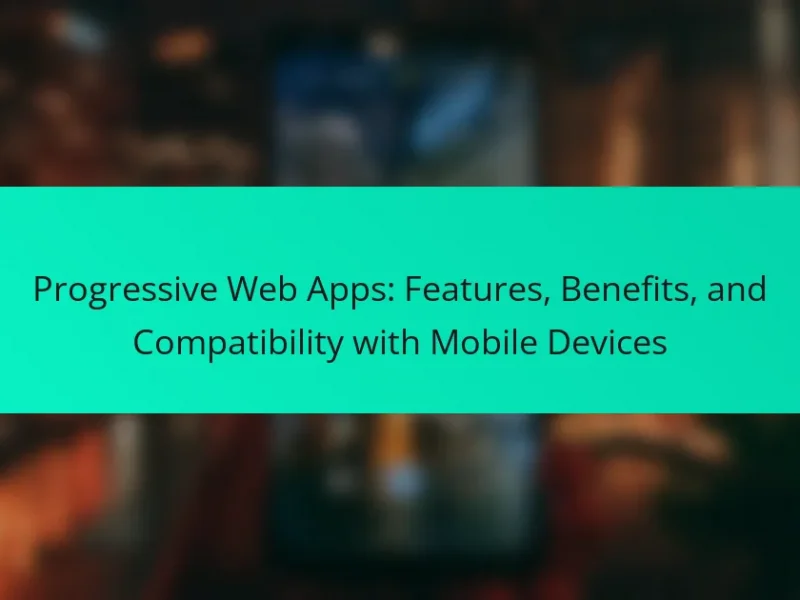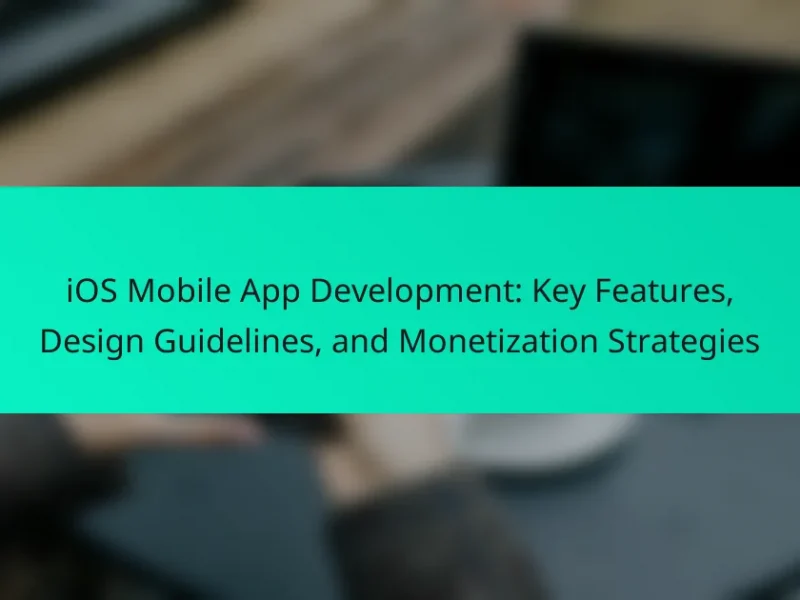Mobile app development for Smart TVs focuses on creating applications tailored for smart television platforms, such as Android TV, Tizen, and webOS. This process involves optimizing user interfaces for larger screens and ensuring effective navigation via remote controls. Developers also address unique features like voice control and integration with streaming services to enhance user experience. The growing demand for smart TV applications is underscored by a Statista report projecting the global smart TV market to exceed 1.5 billion units by 2025. This article explores the unique features, user interaction considerations, and design challenges associated with mobile app development for Smart TVs.

What is Mobile App Development for Smart TVs?
Mobile app development for Smart TVs involves creating applications specifically designed to run on smart television platforms. This process includes programming for various operating systems like Android TV, Tizen, and webOS. Developers focus on optimizing user interfaces for larger screens and remote control navigation. Additionally, they must consider unique features such as voice control and integration with streaming services. According to a report by Statista, the global smart TV market is projected to reach over 1.5 billion units by 2025, highlighting the growing demand for smart TV applications.
How does mobile app development for smart TVs differ from traditional app development?
Mobile app development for smart TVs differs from traditional app development primarily in user interface design and interaction methods. Smart TVs utilize larger screens, requiring a different approach to layout and navigation. Traditional apps often rely on touch input, while smart TV apps depend on remote controls, voice commands, or mobile device integration.
Additionally, smart TV apps must consider varying screen resolutions and aspect ratios, impacting design choices. Performance optimization is crucial for smart TVs, as they may have less processing power than mobile devices.
Furthermore, smart TV platforms, such as Android TV or Roku, have unique development environments and guidelines. This necessitates platform-specific adaptations in coding and functionality. Overall, these factors create a distinct development process tailored to the unique characteristics of smart TVs.
What unique platforms are used for smart TV app development?
Unique platforms for smart TV app development include Tizen, webOS, Android TV, and Roku OS. Tizen is used by Samsung smart TVs and supports HTML5 applications. WebOS powers LG smart TVs and also utilizes HTML5 for app development. Android TV is based on the Android operating system, allowing developers to use Java and Kotlin. Roku OS is a platform for Roku devices, enabling development with BrightScript and SceneGraph. Each platform has unique development tools and guidelines tailored to its ecosystem.
What programming languages are commonly utilized in smart TV app development?
JavaScript, HTML, and CSS are commonly utilized in smart TV app development. These languages are essential for creating interactive and visually appealing applications. JavaScript enables dynamic content and user interaction. HTML provides the structure for the app’s interface. CSS is used for styling the visual elements. Additionally, platforms like Android TV and Tizen support these languages. Their widespread use is backed by the need for cross-platform compatibility. This allows developers to reach a larger audience with minimal effort.
What are the key unique features of mobile apps for smart TVs?
Mobile apps for smart TVs have several key unique features. They are designed for larger screens, providing optimized visual layouts. These apps often integrate with remote controls, allowing for navigation through directional inputs. Voice control capabilities are frequently included, enhancing user interaction. Smart TV apps often support multi-device synchronization, enabling seamless content sharing across devices. They typically offer content recommendations tailored to viewer preferences. Additionally, they may incorporate interactive features, such as real-time polls or social media integration during broadcasts. These unique features enhance user engagement and improve the overall viewing experience.
How do smart TVs enhance user experience through mobile apps?
Smart TVs enhance user experience through mobile apps by providing seamless integration with various streaming services and interactive content. Users can easily access their favorite shows and movies through dedicated applications. Mobile apps also allow for personalized recommendations based on viewing habits. The use of companion apps enables control over the TV, enhancing navigation and interaction. For instance, users can use their smartphones as remote controls, simplifying the user interface. Additionally, many smart TVs support voice commands through mobile apps, improving accessibility. According to a report by Statista, over 80% of smart TV users utilize mobile apps for content consumption. This indicates a strong correlation between mobile app usage and enhanced viewing experiences.
What functionalities are essential for smart TV applications?
Essential functionalities for smart TV applications include content streaming, user authentication, and device compatibility. Content streaming allows users to access various media services seamlessly. User authentication ensures secure access to personalized content. Device compatibility enables applications to function across different smart TV brands and models. Additional functionalities may include voice control, search capabilities, and social media integration. Voice control enhances user interaction by enabling hands-free navigation. Search capabilities allow users to find content quickly and efficiently. Social media integration fosters community engagement and sharing of viewing experiences. These functionalities are crucial for delivering a comprehensive user experience on smart TVs.
Why is user interaction crucial in mobile app development for smart TVs?
User interaction is crucial in mobile app development for smart TVs because it directly influences user engagement and satisfaction. Smart TVs are typically used in shared environments, requiring intuitive and accessible interfaces. Effective user interaction design enhances the viewing experience by simplifying navigation and content discovery. Research indicates that 70% of users abandon apps due to poor usability. Therefore, optimizing user interaction can significantly reduce churn rates. Additionally, smart TVs often integrate with other devices, necessitating seamless interaction across platforms. This interconnectedness fosters a more cohesive ecosystem, enhancing overall user experience.
What are the primary methods of user interaction on smart TVs?
The primary methods of user interaction on smart TVs include remote controls, voice commands, touch screens, and mobile apps. Remote controls allow users to navigate menus and select content easily. Voice commands enable hands-free operation, enhancing accessibility. Touch screens, available on some models, provide intuitive interaction. Mobile apps complement traditional controls by allowing users to interact via smartphones or tablets. According to a study by Nielsen, 60% of smart TV users prefer voice commands for ease of use. These methods collectively enhance user experience and engagement with smart TV content.
How do user interface design principles apply to smart TV applications?
User interface design principles are crucial for smart TV applications. They ensure usability and enhance user experience on large screens. Key principles include simplicity, clarity, and consistency. Smart TV interfaces must be easy to navigate with a remote control. Clear visual hierarchy helps users identify important features quickly. Consistent design elements create familiarity, reducing the learning curve. Touch targets should be large enough for easy selection from a distance. Feedback mechanisms confirm user actions, improving interaction satisfaction. Research shows that well-designed interfaces can increase user engagement and retention by up to 70%.
What design challenges are faced in mobile app development for smart TVs?
Design challenges in mobile app development for smart TVs include screen size limitations and user interface complexity. Smart TVs have larger screens compared to mobile devices, requiring different layout designs. The remote control navigation presents usability issues, as users interact differently than with touchscreens. Content accessibility is crucial, necessitating clear visual hierarchies and readable text sizes. Additionally, performance optimization is essential due to varying hardware capabilities among smart TVs. Ensuring compatibility across multiple operating systems adds to the complexity. These challenges necessitate a focus on intuitive design and user experience to enhance engagement.
How do screen size and resolution impact app design for smart TVs?
Screen size and resolution significantly impact app design for smart TVs. Larger screens require larger, more readable text and interface elements. High resolution enhances image clarity, making visuals more appealing. Designers must consider viewing distance; users sit farther from TVs than from mobile devices. This distance affects how details and interactions are perceived. For example, buttons must be larger to ensure usability from a distance. Additionally, resolution influences the quality of graphics and video content. Apps must be optimized for various resolutions, such as 4K or HD, to maintain quality. Consistent design across different screen sizes and resolutions is crucial for a seamless user experience.
What are the common usability issues in smart TV app interfaces?
Common usability issues in smart TV app interfaces include navigation difficulties, poor layout, and input challenges. Users often struggle with complex navigation menus. This complexity can lead to frustration and confusion. Many smart TV apps have inconsistent design elements. This inconsistency can hinder user familiarity and ease of use. Input methods, such as remote controls, are often limited. This limitation can make text entry and selection cumbersome. Additionally, screen readability can be a problem due to small font sizes. Users may find it hard to read content from a distance. Furthermore, slow response times can disrupt the user experience. These factors collectively contribute to a suboptimal interaction with smart TV apps.
How can developers ensure optimal performance of smart TV applications?
Developers can ensure optimal performance of smart TV applications by following best practices in coding and design. They should prioritize efficient resource management to minimize memory usage. Using lightweight frameworks can enhance loading times and responsiveness. Developers must also optimize images and media files to reduce bandwidth consumption. Testing on multiple devices ensures compatibility and performance consistency. Regular updates and maintenance address bugs and improve functionality. Adhering to platform-specific guidelines enhances user experience and performance. These practices lead to smoother operation and higher user satisfaction.
What best practices should be followed during the development process?
Best practices during the development process for mobile apps on smart TVs include user-centered design, rigorous testing, and performance optimization. User-centered design prioritizes the needs and preferences of users. This involves creating intuitive navigation and ensuring accessibility for diverse audiences. Rigorous testing identifies bugs and usability issues before launch. Testing should encompass various devices and screen sizes to ensure compatibility. Performance optimization enhances the app’s speed and responsiveness. This can be achieved by minimizing load times and reducing resource consumption. Consistent updates and maintenance are also crucial to address user feedback and evolving technology. Following these practices leads to a more successful app that meets user expectations and performs reliably.
How can developers troubleshoot common issues in smart TV apps?
Developers can troubleshoot common issues in smart TV apps by following systematic debugging techniques. First, they should utilize the built-in debugging tools provided by the smart TV platform. These tools can help identify errors in the app’s code. Next, developers should check the app’s compatibility with different smart TV models and operating systems. Incompatibility can lead to performance issues.
Additionally, reviewing logs for error messages can provide insights into specific problems. Developers should also test the app on multiple devices to ensure consistent performance. Network connectivity issues can affect app functionality, so verifying internet access is crucial. Lastly, consulting the platform’s documentation can offer solutions for known issues.
By applying these methods, developers can effectively address and resolve common challenges in smart TV app development.
What are the future trends in mobile app development for smart TVs?
Future trends in mobile app development for smart TVs include increased integration with AI and machine learning. These technologies enhance user personalization and content recommendations. Voice control and smart assistants are becoming standard features. This shift allows for hands-free navigation and interaction. Additionally, cross-platform compatibility is gaining importance. Developers are focusing on creating apps that work seamlessly across devices. The demand for interactive content is rising, especially in gaming and streaming. Enhanced user interfaces will prioritize simplicity and accessibility. Finally, the adoption of 5G technology will improve app performance and streaming quality.
How will advancements in technology influence smart TV app development?
Advancements in technology will significantly influence smart TV app development. Enhanced processing power allows for more complex applications with richer user experiences. Improved internet speeds enable seamless streaming and faster downloads. The rise of artificial intelligence facilitates personalized content recommendations. Additionally, advancements in user interface design lead to more intuitive navigation. Integration with smart home devices expands functionality beyond traditional viewing. The growing use of cloud computing supports storage and processing capabilities. Finally, increased compatibility with various platforms encourages broader app availability.
What emerging features should developers consider for future smart TV applications?
Developers should consider integrating voice control capabilities into future smart TV applications. Voice control enhances user interaction by allowing hands-free navigation. This feature is increasingly popular, with 55% of smart TV users preferring voice commands for searching content. Another emerging feature is personalized content recommendations powered by AI algorithms. These algorithms analyze viewing habits to suggest relevant shows and movies. Additionally, developers should focus on enhanced interactivity through second-screen experiences. This allows users to engage with content on their mobile devices while watching TV. Incorporating augmented reality (AR) features can also enrich user experiences. AR can overlay information on the screen, providing context and enhancing storytelling. Finally, developers should prioritize seamless integration with smart home devices. This creates a cohesive ecosystem for users, allowing control of various devices from the TV interface.
What practical tips can enhance mobile app development for smart TVs?
To enhance mobile app development for smart TVs, focus on optimizing user interface design for large screens. Ensure that navigation is intuitive and accessible. Utilize remote control compatibility for seamless user interaction. Implement voice control features to improve accessibility and convenience. Test apps on various smart TV models to ensure compatibility and performance. Prioritize performance optimization to prevent lag and improve user experience. Incorporate multimedia support for diverse content formats. Ensure that the app adheres to platform-specific guidelines for better integration.
Mobile app development for Smart TVs involves creating applications tailored to smart television platforms, focusing on unique features such as voice control, remote navigation, and integration with streaming services. This article explores the differences between mobile app development for smart TVs and traditional app development, highlighting essential functionalities, design challenges, and user interaction methods. Additionally, it discusses the programming languages used, the impact of screen size and resolution on design, and future trends in technology that will shape smart TV applications. Key best practices for optimizing performance and enhancing user experience are also addressed.


